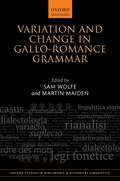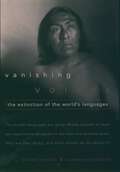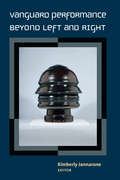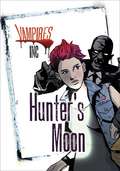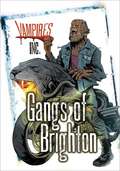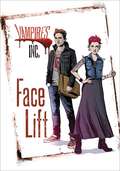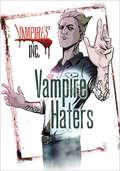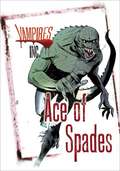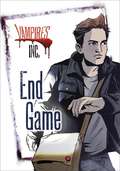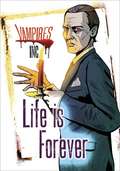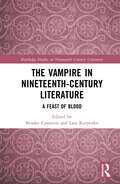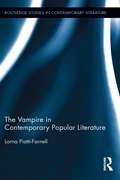- Table View
- List View
Variation in P: Comparative Approaches to Adpositional Phrases (Oxford Studies in Comparative Syntax)
Variation in P is an essential follow-up to the seminal proposals of the generative tradition regarding prepositional syntax. Recent research shows that prepositional phrases have a complex internal structure, and that the grammatical encoding of locative meaning has its own place in universal grammar. The papers collected in the first part of this volume not only test these proposals against new comparative data, but also shed light on the relation between spatial expressions and other semantic relations like possession. The second part of the volume explores the role of prepositions in non-spatial environments as well as in more general phenomena like verbal affixation, ellipsis, and complementation. By drawing on evidence from less studied languages, and by considering prepositional syntax in interaction with clausal syntax as well as within prepositional phrases, Variation in P refines and develops theories introduced by previous generative studies.
Variation in Non-finite Constructions in English: Trends Affecting Infinitives and Gerunds
by Mark Kaunisto Juhani RudankoThis book sheds new light on the nature of gerunds in English, utilizing data from very large electronic corpora in order to compare pairs of patterns viewed as constructions. It serves as a contribution to the study of complementation, an under-researched area of investigation which bridges observations at the intersection of lexico-grammar, syntax and semantics. As a result, the reader develops their understanding of the meaning and use of each pattern within the system of English predicate complementation as it has evolved in recent times. This book will be of interest to students and scholars of English linguistics, especially English grammar.
Variation in Linguistic Systems
by James A. WalkerTying together work on a number of languages and linguistic varieties in different locales, this book provides students and researchers with a convenient, unified overview of variationist analysis in linguistics. Variation in Linguistic Systems takes a theoretical and quantitative approach to the study of variation in language, focusing on the role of language-internal constraints on variation and the relation of linguistic variation to linguistic theory. It introduces the basic concepts of variationist linguistics and includes key discussions on language change, language contact, the different types of variation, multivariate analysis with GoldVarb, and variation in sound and grammatical systems. Here is an ideal textbook for an introductory course on variation, as well as a useful resource for scholars with some background in linguistics who are interested in the study of language variation and its relation to the wider field of linguistics.
Variation in Linguistic Systems
by James A. WalkerTying together work on a number of languages and linguistic varieties in different locales, this book provides students and researchers with a convenient, unified overview of variationist analysis in linguistics. Variation in Linguistic Systems takes a theoretical and quantitative approach to the study of variation in language, focusing on the role of language-internal constraints on variation and the relation of linguistic variation to linguistic theory. It introduces the basic concepts of variationist linguistics and includes key discussions on language change, language contact, the different types of variation, multivariate analysis with GoldVarb, and variation in sound and grammatical systems. Here is an ideal textbook for an introductory course on variation, as well as a useful resource for scholars with some background in linguistics who are interested in the study of language variation and its relation to the wider field of linguistics.
Variation in English: Multi-Dimensional Studies (Studies in Language and Linguistics)
by Douglas Biber Susan ConradStudies in Language and LinguisticsGeneral Editors- Geoffrey Leech, Department of Modern English Language, Lancaster University and Jenny Thomas, School of English and Linguistics, University of Wales, BangorBroad-ranging and authoritative, Studies in Language and Linguistics is an occasional seriesincorporating major new work in all areas of linguistics. Variation in English- Multi-Dimensional Studies provides both a comprehensive view into a relatively new technique for studying language, and a diverse, exciting collection of studies of variation in English. The first part of the book provides an explanation of multi-dimensional (MD) analysis, a research technique for studying language variation. MD is a corpus-based approach developed by Doug Biber that facilitates large-scale studies of language variation and the investigation of research questions that were previously intractable. The second part of the book contains studies that apply Biber's original MD analysis of English to new domains. These studies cover the historical evolution of English; specialized domains such as medical writing and oral proficiency testing; and dialect variation, including gender and British/American.The third part of the book contains studies that conduct new MD analyses, covering adult/child language differences, 18th century speech and writing, and discourse complexity. Readers of this book will become familiar with the analytical techniques of multi-dimensional analysis, with its applicability to a wide variety of language issues, and with the findings of important studies previously published in diverse journals as well as new studies appearing for the first time.
Variation in English: Multi-Dimensional Studies (Studies in Language and Linguistics)
by Douglas Biber Susan ConradStudies in Language and LinguisticsGeneral Editors- Geoffrey Leech, Department of Modern English Language, Lancaster University and Jenny Thomas, School of English and Linguistics, University of Wales, BangorBroad-ranging and authoritative, Studies in Language and Linguistics is an occasional seriesincorporating major new work in all areas of linguistics. Variation in English- Multi-Dimensional Studies provides both a comprehensive view into a relatively new technique for studying language, and a diverse, exciting collection of studies of variation in English. The first part of the book provides an explanation of multi-dimensional (MD) analysis, a research technique for studying language variation. MD is a corpus-based approach developed by Doug Biber that facilitates large-scale studies of language variation and the investigation of research questions that were previously intractable. The second part of the book contains studies that apply Biber's original MD analysis of English to new domains. These studies cover the historical evolution of English; specialized domains such as medical writing and oral proficiency testing; and dialect variation, including gender and British/American.The third part of the book contains studies that conduct new MD analyses, covering adult/child language differences, 18th century speech and writing, and discourse complexity. Readers of this book will become familiar with the analytical techniques of multi-dimensional analysis, with its applicability to a wide variety of language issues, and with the findings of important studies previously published in diverse journals as well as new studies appearing for the first time.
Variation and Morphosyntactic Change in Greek: From Clitics to Affixes (Palgrave Studies in Language History and Language Change)
by P. PappasThis book deals with some of the major theoretical and descriptive concerns of the historical linguist. The author presents a variationist analysis of weak object pronoun placement in Greek during a transitional period of the language when these elements exhibited both clitic-like and affix-like behaviour. The statistical analysis of the data, providing the first accurate description of the pattern of variation, is used in showing that existing accounts fall short of a full explanation. An alternative approach forces re-evaluation of the role of generalizations in linguistic explanation.
Variation and Change in Gallo-Romance Grammar (Oxford Studies in Diachronic and Historical Linguistics #41)
This volume offers a wide-range of case studies on variation and change in the sub-family of the Romance languages that includes French and Occitan: Gallo-Romance. Both standard and non-standard Gallo-Romance data can be of enormous value to studies of morphosyntactic variation and change, yet, as the volume demonstrates, non-standard and comparative Gallo-Romance data have often been lacking in both synchronic and diachronic studies. Following an introduction that sets out the conceptual background, the volume is divided into three parts whose chapters explore a variety of topics in the domains of sentence structure, the verb complex, and word structure. The empirical foundation of the volume is exceptionally rich, drawing on standard and non-standard data from French, Occitan, Francoprovençal, Picard, Wallon, and Norman. This diversity is also reflected in the theoretical and conceptual approaches adopted, which span traditional philology, sociolinguistics, formal morphological and syntactic theory, semantics, and discourse-pragmatics. The volume will thus be an indispensable tool for researchers and students in French and (Gallo-) Romance linguistics as well as for readers interested in grammatical theory, sociolinguistics, and historical linguistics.
Vargas Llosa and Latin American Politics
by Juan E. De Castro Nicholas BirnsMario Vargas Llosa is a heterogeneous writer whose positions have often not been consistent from novel to novel, between his fictional and nonfictional work, between his literary and political commentary, and as his political commentary has proceeded over the decades. This analysis of his work reveals his insights into socio-political matters.
Vanity Fair and the Celestial City: Dissenting, Methodist, and Evangelical Literary Culture in England 1720-1800
by Isabel RiversIn John Bunyan's The Pilgrim's Progress, the pilgrims cannot reach the Celestial City without passing through Vanity Fair, where everything is bought and sold. In recent years there has been much analysis of commerce and consumption in Britain during the long eighteenth century, and of the dramatic expansion of popular publishing. Similarly, much has been written on the extraordinary effects of the evangelical revivals of the eighteenth century in Britain, Europe, and North America. But how did popular religious culture and the world of print interact? It is now known that religious works formed the greater part of the publishing market for most of the century. What religious books were read, and how? Who chose them? How did they get into people's hands? Vanity Fair and the Celestial City is the first book to answer these questions in detail. It explores the works written, edited, abridged, and promoted by evangelical dissenters, Methodists both Arminian and Calvinist, and Church of England evangelicals in the period 1720 to 1800. Isabel Rivers also looks back to earlier sources and forward to the continued republication of many of these works well into the nineteenth century. The first part is concerned with the publishing and distribution of religious books by commercial booksellers and not-for-profit religious societies, and the means by which readers obtained them and how they responded to what they read. The second part shows that some of the most important publications were new versions of earlier nonconformist, episcopalian, Roman Catholic, and North American works. The third part explores the main literary kinds, including annotated bibles, devotional guides, exemplary lives, and hymns. Building on many years' research into the religious literature of the period, Rivers discusses over two hundred writers and provides detailed case studies of popular and influential works.
Vanity Fair and the Celestial City: Dissenting, Methodist, and Evangelical Literary Culture in England 1720-1800
by Isabel RiversIn John Bunyan's The Pilgrim's Progress, the pilgrims cannot reach the Celestial City without passing through Vanity Fair, where everything is bought and sold. In recent years there has been much analysis of commerce and consumption in Britain during the long eighteenth century, and of the dramatic expansion of popular publishing. Similarly, much has been written on the extraordinary effects of the evangelical revivals of the eighteenth century in Britain, Europe, and North America. But how did popular religious culture and the world of print interact? It is now known that religious works formed the greater part of the publishing market for most of the century. What religious books were read, and how? Who chose them? How did they get into people's hands? Vanity Fair and the Celestial City is the first book to answer these questions in detail. It explores the works written, edited, abridged, and promoted by evangelical dissenters, Methodists both Arminian and Calvinist, and Church of England evangelicals in the period 1720 to 1800. Isabel Rivers also looks back to earlier sources and forward to the continued republication of many of these works well into the nineteenth century. The first part is concerned with the publishing and distribution of religious books by commercial booksellers and not-for-profit religious societies, and the means by which readers obtained them and how they responded to what they read. The second part shows that some of the most important publications were new versions of earlier nonconformist, episcopalian, Roman Catholic, and North American works. The third part explores the main literary kinds, including annotated bibles, devotional guides, exemplary lives, and hymns. Building on many years' research into the religious literature of the period, Rivers discusses over two hundred writers and provides detailed case studies of popular and influential works.
The Vanishing World of The Islandman: Narrative and Nostalgia (Palgrave Studies in Literary Anthropology)
by Máiréad Nic CraithExploring An t-Oileánach (anglicised as The Islandman), an indigenous Irish-language memoir written by Tomás Ó Criomhthain (Tomás O'Crohan), Máiréad Nic Craith charts the development of Ó Criomhthain as an author; the writing, illustration, and publication of the memoir in Irish; and the reaction to its portrayal of an authentic, Gaelic lifestyle in Ireland. As she probes the appeal of an island fisherman’s century-old life-story to readers in several languages—considering the memoir’s global reception in human, literary and artistic terms—Nic Craith uncovers the indelible marks of Ó Criomhthain’s writing closer to home: the Blasket Island Interpretive Centre, which seeks to institutionalize the experience evoked by the memoir, and a widespread writerly habit amongst the diasporic population of the Island. Through the overlapping frames of literary analysis, archival work, interviews, and ethnographic examination, nostalgia emerges and re-emerges as a central theme, expressed in different ways by the young Irish state, by Irish-American descendants of Blasket Islanders in the US today, by anthropologists, and beyond.
Vanishing Voices: The Extinction of the World's Languages
by Daniel Nettle Suzanne RomaineFew people know that nearly one hundred native languages once spoken in what is now California are near extinction, or that most of Australia's 250 aboriginal languages have vanished. In fact, at least half of the world's languages may die out in the next century. Daniel Nettle and Suzanne Romaine assert that this trend is far more than simply disturbing. Making explicit the link between language survival and environmental issues, they argue that the extinction of languages is part of the larger picture of near-total collapse of the worldwide ecosystem. Indeed, the authors contend that the struggle to preserve precious environmental resources-such as the rainforest-cannot be separated from the struggle to maintain diverse cultures, and that the causes of language death, like that of ecological destruction, lie at the intersection of ecology and politics. In addition to defending the world's endangered languages, the authors also pay homage to the last speakers of dying tongues, such as Red Thundercloud, a Native American in South Carolina; Ned Mandrell, with whom the Manx language passed away in 1974; and Arthur Bennett, an Australian who was the last person to know more than a few words of Mbabaram. In our languages lies the accumulated knowledge of humanity. Indeed, each language is a unique window on experience. Vanishing Voices is a call to preserve this resource, before it is too late.
Vanishing Moments: Class and American Literature (Class : Culture)
by Eric SchocketVanishing Moments analyzes how various American authors have reified class through their writing, from the first influx of industrialism in the 1850s to the end of the Great Depression in the early 1940s. Eric Schocket uses this history to document America’s long engagement with the problem of class stratification and demonstrates how deeply America’s desire to deny the presence of class has marked even its most labor-conscious cultural texts. Schocket offers careful readings of works by Herman Melville, Rebecca Harding Davis, William Dean Howells, Jack London, T. S. Eliot, Gertrude Stein, Muriel Rukeyser, and Langston Hughes, among others, and explores how these authors worked to try to heal the rift between the classes. He considers the challenges writers faced before the Civil War in developing a language of class amidst the predominant concerns about race and slavery; how early literary realists dealt with the threat of class insurrection; how writers at the turn of the century attempted to span the divide between the classes by going undercover as workers; how early modernists used working-class characters and idioms to shape their aesthetic experiments; and how leftists in the 1930s struggled to develop an adequate model to connect class and literature. Vanishing Moments’ unique combination of a broad historical scope and in-depth readings makes it an essential book for scholars and students of American literature and culture, as well as for political scientists, economists, and humanists. Eric Schocket is Associate Professor of American Literature at Hampshire College. “An important book containing many brilliant arguments—hard-hitting and original. Schocket demonstrates a sophisticated acquaintance with issues within the working-class studies movement.” --Barbara Foley, Rutgers University
Vanguard Performance Beyond Left and Right
by Kimberly JannaroneVanguard Performance Beyond Left and Right challenges assumptions regarding “radical” and “experimental” performance that have long dominated thinking about the avant-garde. The book brings to light vanguard performances rarely discussed: those that support totalitarian regimes, promote conservative values, or have been effectively snapped up by right-wing regimes the performances intended to oppose. In so doing, the volume explores a central paradox: how innovative performances that challenge oppressive power structures can also be deployed in deliberate, passionate support of oppressive power. Essays by leading international scholars pose engaging questions about the historical avant-garde, vanguard acts, and the complex role of artistic innovation and live performance in global politics. Focusing on performances that work against progressive and democratic ideas (including scripted drama, staged suicide, choral dance, terrorism, rallies, and espionage), the book demonstrates how many compelling performance ideals—unification, exaltation, immersion—are, in themselves, neither moral nor immoral; they are only emotional and aesthetic urges that can be powerfully channeled into a variety of social and political outlets.
Vampires Inc: Hunter's Moon (PDF)
by Paul BlumJohn Logan may write books about the supernatural, but he doesn't believe in it. Rose Petal is a vampire hunter who helps keep order in Brighton, a beachfront city with a secret. When bite marks are found on a body, Rose is called in to solve the crime and John is about to discover that the real world is stranger than anything he could make up ... The new Vampires Inc. stories offer page-turning, achievable reads for learners who may struggle with full-length fiction but want to engage with this genre. With pacey narrative and plenty of dialogue, the series will capture the imagination of the most reluctant reader.
Vampires Inc: Gangs of Brighton (PDF)
by Paul BlumThere's trouble brewing in Brighton when a gang of werewolf bikers come to town. The Lukos Chapter are on a mission to track down one particular vampire. And he just happens to be Rose Petal s new boyfriend ... The new Vampires Inc. stories offer page-turning, achievable reads for learners who may struggle with full-length fiction but want to engage with this genre. With pacey narrative and plenty of dialogue, the series will capture the imagination of the most reluctant reader.nbsp;
Vampires Inc: Face Lift (PDF)
by Paul BlumJohn Logan is a successful author, researching his second book on vampires. John has been approached by Rose Petal to be his research assistant. Rose lives in Brighton and knows a lot more about what goes on after dark in this seaside city than John can ever imagine.
Vampires Inc: Vampire Haters (PDF)
by Paul BlumIts Halloween and not everyone is in a party mood. An escaped convict has a deadly grudge against Brighton s vampires. Who will be the next victim of this vampire hater? The new Vampires Inc. stories offer page-turning, achievable reads for learners who may struggle with full-length fiction but want to engage with this genre. With pacey narrative and plenty of dialogue, the series will capture the imagination of the most reluctant reader.nbsp;
Vampires Inc: Ace of Spades (PDF)
by Paul BlumJohn Logan is going undercover to help solve a murder. The chief suspect is a well-known gangster, but his henchmen are a different species altogether. In this game, the odds of John making it through the night are slim ... The new Vampires Inc. stories offer page-turning, achievable reads for learners who may struggle with full-length fiction but want to engage with this genre. With pacey narrative and plenty of dialogue, the series will capture the imagination of the most reluctant reader.nbsp;
Vampires Inc: End Game (PDF)
by Paul BlumFear is spreading through Brighton's supernatural community. Every night more vampires go missing. When John and Rose finally get a lead on the mysterious Ace of Spades project, they need back-up from two dangerous enemies to stop the war that is brewing.
Vampires Inc: Life is Forever (PDF)
by Paul BlumA haunted church, a missing teacher and a dead student lead John Logan and Rose Petal to a man with a dark secret. Joseph Judd certainly isn t what he seems, but what exactly is he? The new Vampires Inc. stories offer page-turning, achievable reads for learners who may struggle with full-length fiction but want to engage with this genre. With pacey narrative and plenty of dialogue, the series will capture the imagination of the most reluctant reader.
The Vampire in Nineteenth-Century Literature: A Feast of Blood (Routledge Studies in Nineteenth Century Literature)
by Brooke CameronAgainst the social and economic upheavals that characterized the nineteenth century, the border-bending nosferatu embodied the period’s fears as well as its forbidden desires. This volume looks at both the range among and legacy of vampires in the nineteenth century, including race, culture, social upheaval, gender and sexuality, new knowledge and technology. The figure increased in popularity throughout the century and reached its climax in Dracula (1897), the most famous story of bloodsuckers. This book includes chapters on Bram Stoker’s iconic novel, as well as touchstone texts like John William Polidori’s The Vampyre (1819) and Sheridan Le Fanu’s Carmilla (1872), but it also focuses on the many “Other” vampire stories of the period. Topics discussed include: the long-war veteran and aristocratic vampire in Varney; the vampire as addict in fiction by George MacDonald; time discipline in Eric Stenbock’s Studies of Death; fragile female vampires in works by Eliza Lynn Linton; the gender and sexual contract in Mary Elizabeth Braddon’s “Good Lady Ducayne;” cultural appropriation in Richard Burton’s Vikram and the Vampire; as well as Caribbean vampires and the racialized Other in Florence Marryat’s The Blood of the Vampire. While drawing attention to oft-overlooked stories, this study ultimately highlights the vampire as a cultural shape-shifter whose role as “Other” tells us much about Victorian culture and readers’ fears or desires.
The Vampire in Nineteenth-Century Literature: A Feast of Blood (Routledge Studies in Nineteenth Century Literature)
by Brooke Cameron Lara KarpenkoAgainst the social and economic upheavals that characterized the nineteenth century, the border-bending nosferatu embodied the period’s fears as well as its forbidden desires. This volume looks at both the range among and legacy of vampires in the nineteenth century, including race, culture, social upheaval, gender and sexuality, new knowledge and technology. The figure increased in popularity throughout the century and reached its climax in Dracula (1897), the most famous story of bloodsuckers. This book includes chapters on Bram Stoker’s iconic novel, as well as touchstone texts like John William Polidori’s The Vampyre (1819) and Sheridan Le Fanu’s Carmilla (1872), but it also focuses on the many “Other” vampire stories of the period. Topics discussed include: the long-war veteran and aristocratic vampire in Varney; the vampire as addict in fiction by George MacDonald; time discipline in Eric Stenbock’s Studies of Death; fragile female vampires in works by Eliza Lynn Linton; the gender and sexual contract in Mary Elizabeth Braddon’s “Good Lady Ducayne;” cultural appropriation in Richard Burton’s Vikram and the Vampire; as well as Caribbean vampires and the racialized Other in Florence Marryat’s The Blood of the Vampire. While drawing attention to oft-overlooked stories, this study ultimately highlights the vampire as a cultural shape-shifter whose role as “Other” tells us much about Victorian culture and readers’ fears or desires.
The Vampire in Contemporary Popular Literature (Routledge Studies in Contemporary Literature)
by Lorna Piatti-FarnellProminent examples from contemporary vampire literature expose a desire to re-evaluate and re-work the long-standing, folkloristic interpretation of the vampire as the immortal undead. This book explores the "new vampire" as a literary trope, offering a comprehensive critical analysis of vampires in contemporary popular literature and demonstrating how they engage with essential cultural preoccupations, anxieties, and desires. Drawing from cultural materialism, anthropology, psychoanalysis, literary criticism, gender studies, and postmodern thought, Piatti-Farnell re-frames the concept of the vampire in relation to a distinctly twenty-first century brand of Gothic imagination, highlighting important aesthetic, conceptual, and cultural changes that have affected the literary genre in the post-2000 era. She places the contemporary literary vampire within the wider popular culture scope, also building critical connections with issues of fandom and readership. In reworking the formulaic elements of the vampiric tradition — and experimenting with genre-bending techniques — this book shows how authors such as J.R. Ward, Stephanie Meyers, Charlaine Harris, and Anne Rice have allowed vampires to be moulded into enigmatic figures who sustain a vivid conceptual debt to contemporary consumer and popular culture. This book highlights the changes — conceptual, political and aesthetic — that vampires have undergone in the past decade, simultaneously addressing how these changes in "vampire identity" impact on the definition of the Gothic as a whole.





